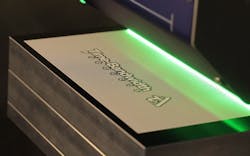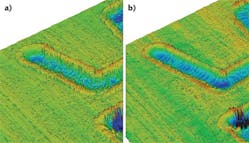HUBERT AMMANN and ANDREAS OEHLER
The implementation of picosecond lasers for material microprocessing has taken great strides in the last 10 years. Since the first suitable lasers appeared, they have seen substantial advancement and are now widely recognized as reliable tools for industrial use. In the same period, considerable process knowledge has also been gained, further paving the way for their acceptance.
One major hurdle preventing the implementation of any innovative technology resides in the associated investment costs: capital and running costs for the laser and the process system, as well as the development costs of a reliable and effective process. In general, these costs are only justified when the existing processing methods cannot deliver the required finish, when the process itself only becomes possible through the implementation of the ultrafast laser, or when manufacturing can be made more economical. The latter might be achieved through omission of any post-processing steps, an increase in throughput, a reduction of wear and tear on the process system, and/or an improved yield.
Naturally, the primary goal of any process development is to maximize the potential in any and all of these areas, and this is usually achieved through a methodical trial-and-error approach whereby both differing laser parameters and various beam-steering systems are examined. In cases where the laser is capable of providing flexible pulse delivery (flexible repetition rates, pulse modulation, and burst modes), it can help maximize the potential efficiency of any process and the corresponding productivity of the complete system.
Production efficiency
The majority of processes for ultrafast lasers involve the removal of material. A single pulse is capable of removing a thin disk of material roughly 0.1 μm deep, which for a spot size of 20 μm corresponds to a volume of around 10-8 mm3. Around 100 million pulses are needed to remove just 1 mm3 of material.
Regarding throughput, any efficient process fulfills two criteria: (1) the volume of ablated material per unit pulse energy (mm3/μJ) has been optimized; and (2) the process at the workpiece occurs at the maximum possible pulse-repetition rate.
It has been both theoretically and experimentally verified that, for a given beam size, there is an optimal energy per pulse for the efficient removal of material.1 At higher pulse energies, not only does the ablation efficiency decrease, but also more energy is deposited as heat, thus causing a departure from the desired 'athermal' (cold) process and potentially sacrificing machining quality.
One significant issue for many commercially available ultrafast lasers is that the pulse energy can only be set through optical attenuation. The available pulse energy from the laser may be up to a factor of 10 higher than the process requires, so a 50 W laser must effectively be reduced to 5 W to avoid thermal effects. Ideally, one could instead use a type of laser that allows a reduction of the pulse energy by increasing the repetition rate. The full optical power of the laser is thus still available for the process, independent of the required pulse energy.
Given the limitation in the usable pulse energy and the volume removal per pulse, the principal factor available for increasing throughput (efficiency) is then an innovative implementation of higher pulse-repetition rates at the workpiece. For example, as long as 'dead time' due to scan-head dynamics and workpiece positioning can be kept to a minimum, increasing the repetition rate translates linearly to an increase in throughput.
The beam-steering bottleneck
Although propagated widely as a universally valid fact, the concept that ultrafast processing occurs athermally (cold) is actually only true for low numbers of pulses. If sufficient numbers of pulses are incident on the same spot of a workpiece, there is still an accumulation of rest energy that does not contribute to the desired process and is subsequently deposited as heat.
The issue is combatted through minimizing pulse overlap and using multiple passes over the workpiece to achieve the required processing. However, a laser spot of 40 μm with a pulse overlap of 50% and a repetition rate of 2 MHz equates to a translation speed over the workpiece of 40 m/s. By far the greatest limitation for the implementation of higher repetition rates is thus not the availability of commercial laser systems, but instead that of suitable high-speed scanning systems. Conventional scan heads in particular, with maximum translation speeds of around 10 m/s, already restrict the implementation of megahertz and above repetition rates.
In principle, this repetition-rate limitation can be alleviated by using parallel processing systems where the available pulse energy is split between multiple stations; unfortunately, this introduces considerable complexity and cost. Alternatively, the introduction of parallel processing within a single workstation can be realized with diffractive optical elements, but this is usually only applicable to specialized applications.
The need for higher-speed scanning systems has indeed been recognized, and several approaches are currently in development.2 The most promising of these include polygon scanners (see Fig. 1), acousto- and electro-optical deflection, piezo- and microelectromechanical (MEMS) scanners, as well as a combination of these methods.
Further process improvement options
If there are limitations to the usable pulse energy and the maximum available pulse delivery rate at the workpiece, what else can be done to improve the process? Some lasers provide so-called burst modes, and justifiably so, as several studies have shown that certain processes exhibit improved ablation rates and/or machining quality by using pulse bursts instead of single pulses.3
Pulse bursts are groups of ultrashort pulses with separations of around 10 ns and an overall duration of typically 100 ns. Notably, these pulse bursts can only be realized in linear optical amplification configurations, not in regenerative laser systems.
As an example of the impact that bursts-and even the substructure of the bursts-can have on the process quality, consider two different burst sets applied to a workpiece (see Fig. 2). In the manufacture of micro-molds, a laser is traversed once across the workpiece for two slightly different burst configurations: in each case, the burst comprises four pulses of identical energy, but separated by 12 and then 24 ns. The desired improvement, a reduction in surface roughness, is achieved using a 24 ns interval. Not only is the depth variation along the line improved, but the local, medium-range roughness Ra is reduced from 0.4 to 0.25.The solution here was to measure the imperfections in the mold and to then generate a power correction map so that areas of the recess that are too deep are corrected by an on-the-fly appropriate reduction of the laser power. The power correction map and the associated required power scaling at every point yields excellent process improvement: depth variation is reduced to less than 1 μm peak-to-peak across the process field. Equally, this feature can also be used to intentionally modulate the processed depth.
The same laser feature can also be used to take advantage of the acceleration phases of the scan optics. If the speed across the workpiece is changing, this also changes the pulse overlap and so too the removal of material. Continually adjusting the laser power to suit the instantaneous scanner speed permits more efficient use of these phases of the scan-head movement, resulting in a higher overall throughput.
To maximize the throughput of a process, it is therefore necessary to incorporate the flexible delivery of higher pulse-repetition rates at an early stage of the process development. Doing so requires exemplary technical know-how and creativity on the side of the developer, as well as pulse-delivery options from the laser that promote, rather than hinder, the implementation of innovative processes.
REFERENCES
1. B. Neuenschwander et al., "Processing of industrially relevant non metals with laser pulses in the range between 10 ps and 50 ps," Proc. ICALEO, M103, Orlando, FL (2011).
2. Bavarian Photonics Workshop: Schnelle Strahlablenkung für Laseranwendungen, Nürnberg, Germany (April 2013).
3. W. Hu et al., Appl. Phys. A, 98, 407-415 (2010).
Hubert Ammann is VP product manager, industrial laser systems, and Andreas Oehler is application head at Time-Bandwidth Products, Ruetistrasse 12, CH-8952 Schlieren/Zurich, Switzerland; e-mail: [email protected]; www.time-bandwidth.com.


